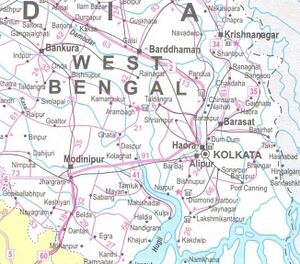Chandraketugarh
| Author:Laxman Burdak, IFS (R) |

Chandraketugarh (चंद्रकेतुगढ़) is an archaeological site located beside the Bidyadhari river, about 35 kms north-east of Kolkata, India, in the district of North 24 parganas, near the township of Berachampa and the Harua Road railhead.
Origin
Variants
- Chandraketugadha/Chandraketugarha (चंद्रकेतुगढ़) (प.बंगाल) (AS, p.316)
History
Years of excavation within 1957-68 (conducted by Asutosh Museum of Indian Art) have revealed relics of several historical periods,[1] although the chronological classification of the relics remains incomplete.
According to some historians, the Chandraketugarh site and surrounding area could be the place known to ancient Greek and Roman writers as having the same name as the river Ganges (Γάγγης)[2] sometimes referred to as 'Gangaridai'. Chandraketugarh is thought to be a part of the ancient kingdom Gangaridai that was first described by Ptolemy.
The history of Chandraketugarh dates back to almost the 3rd century BC, during the pre-Mauryan era. Artefacts suggest that the site was continuously inhabited and flourished through the Shunga-Kushana period, onwards through the Gupta period and finally into the Pala-Sena period.[3]
| Period | Dynasty | Year |
|---|---|---|
| Period I | Maurya | 300-200 BC |
| Period III | Shunga | 200 BC - 50 AD |
| Period IV | Kushan | 50-300 AD |
| Period V | Gupta | 300-500 AD |
| Period VI | Post-Gupta | 500-750 AD |
| Period VII | Pala-Chandra-Sena | 750-1250 AD |
After these periods, there was no such example of any other civilization on the ruin of Chandraketugarh.
Excavations
Archaeological studies suggest that Chandraketugarh was an important town and a port city. It had a high encircling wall complete with a rampart and moat. The residents were involved in various crafts and mercantile activities. Although the religious inclinations of the people are unclear, hints of the beginning of some future cults can be seen in the artefacts. Some of the potteries carry inscriptions in Kharoshthi and Brahmi scripts.
Brahmi inscriptions with Megalithic Graffiti Symbols read "yojanani setuvandhat arddhasatah dvipa tamraparni", meaning "The island of Tamraparni (ancient Sri Lanka) is at a distance of 50 yojanas from Setuvandha (Rameswaram in Tamil Nadu).[4][5] The mast of a ship with Vijayasinha's seal, describing Vijayasinha, the son of the king of Sinhapura of Vanga's marriage to Kuveni – the indigenous "Yakkha queen of Tamraparni".[6] Chandraketugarh features many examples of terracotta art, displaying an unusual degree of precision and craftsmanship. These plaques are comparable to those found at other better-known sites such as Kaushambi and Ahichhatra. The terracotta plaques from these sites often carry similar motifs executed in nearly identical fashion. This similarity suggests an established communication link and common cultural heritage among these sites.
Finds include Northern Black Polished Ware (NBPW) relics, later wares dated from about 400 BC to 100 BC and approximately contemporary with the Maurya period, as well as from the more recent Kushanas and Gupta periods.
A large number of silver punch-marked coins and a few gold coins have been unearthed from Chandraketugarh, including a gold coin of Chandragupta-Kumardevi. A large number of semi-precious stone beads were also found here, along with items made of ivory and bone. Even a few wooden objects have survived. [7]
चंद्रकेतुगढ़
विजयेन्द्र कुमार माथुर[8] ने लेख किया है ...चंद्रकेतुगढ़ (प.बंगाल) (AS, p.316): कोलकाता से 24 मील दूरी पर स्थित है. आशुतोष संग्रहालय, कोलकाता विश्वविद्यालय द्वारा की गई खुदाई में इस स्थान से मौर्य-शुंग काल से लेकर उत्तरगुप्तकाल तक की सभ्यताओं के चिन्ह प्राप्त हुए हैं. सबसे प्राचीन युगों के कच्चे मकानों के अवशेष सबसे निचले स्तरों से मिले हैं. ये लकड़ी बांस आदि के बने हुए हैं. इन मकानों का अग्निकांड द्वारा नष्ट होने का अनुमान किया जाता है. परवर्ती काल में बने हुए ईंटों के पक्के मकानों के चिन्ह उपरले स्तरों में मिले हैं. मौर्यकालीन बस्तियों में पानी के लिए खपरों की बनी नालियों का प्रबंध था. प्राचीन नगर के और कच्ची मिट्टी की मोटी दीवार के अवशेष भी प्रकाश में आए हैं.
External links
References
- ↑ Dr. Gaurishankar de & Prof. Subhradip de, Prasanga: Pratna-Prantar Chandraketugarh, First Edition: 2013, ISBN 978-93-82435-00-6
- ↑ "Merchants, Merchandise and Merchantmen in the Western Seaboard of India: A Maritime Profile (c. 500 BCE-1500 CE)." Ranabir Chakravarti. In: History of Science, Philosophy and Culture in Indian Civilization, Vol. VIII (1), (2012) Om Prakash (Ed.), Centre for Studies in Civilization, Delhi, pp. 69-70.
- ↑ Dr. Gaurishankar de & Prof. Subhradip de, Prasanga: Pratna-Prantar Chandraketugarh, First Edition: 2013, ISBN 978-93-82435-00-6
- ↑ Mondal, Sambhu Nath (2006). Decipherment of the Indus-Brâhmî Inscriptions of Chandraketugarh (Gangâhrada)--the Mohenjodaro of East India. University of Michigan: Shankar Prasad Saha. pp. 32–51.
- ↑ Sambhu Nath Mondal. 2006. Decipherment of the Indus-Brâhmî Inscriptions of Chandraketugarh (Gangâhrada)--the Mohenjodaro of East India. pp28 Sanskritization : "yojanani setuvandhat arddhasatah dvipa tamraparni"
- ↑ Sambhu Nath Mondal. 2006. Decipherment of the Indus-Brâhmî Inscriptions of Chandraketugarh (Gangâhrada)--the Mohenjodaro of East India. pp28 vijayasihasa bivaha sihaurata tambapaniah yakkhini kubanna,a" Sanskritized as "vijayasirihasya vivaha sirihapuratah tamraparnyah yaksinf kubarjuaaya"
- ↑ Dr. Gaurishankar de & Prof. Subhradip de, Prasanga: Pratna-Prantar Chandraketugarh, First Edition: 2013, ISBN 978-93-82435-00-6
- ↑ Aitihasik Sthanavali by Vijayendra Kumar Mathur, p.316

